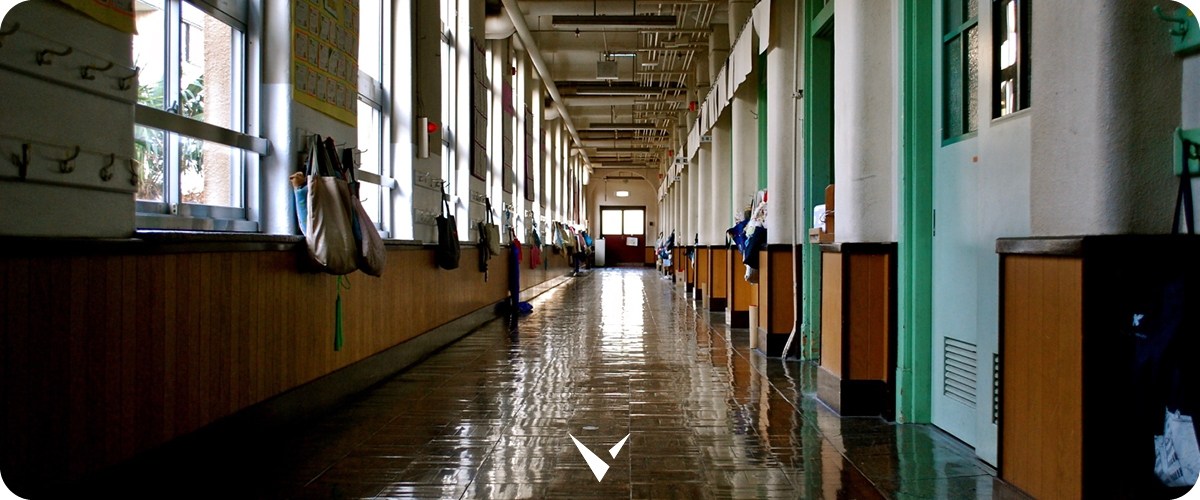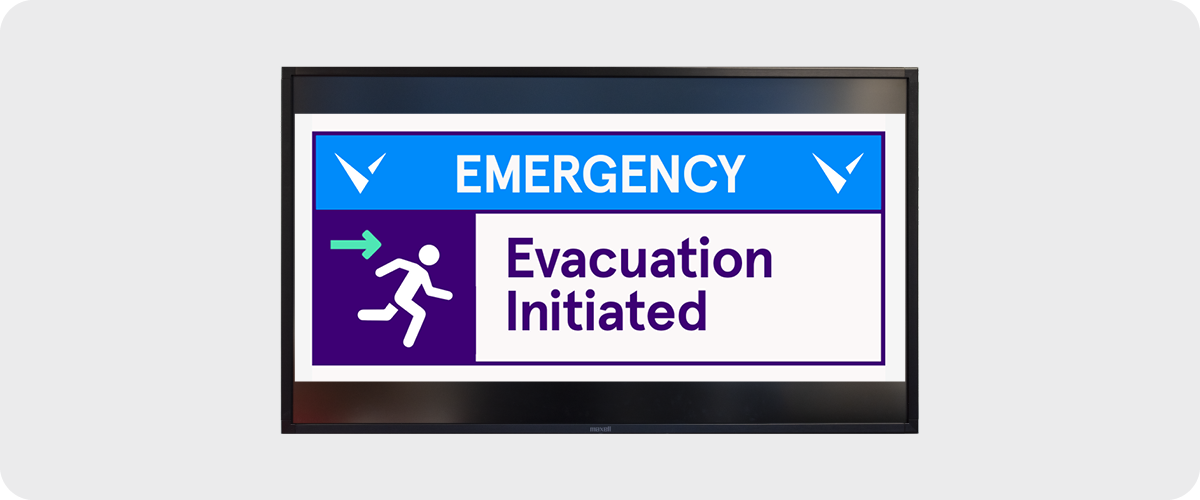Planning & Operationalizing an Emergency Alert System for Schools
10 Important Considerations for Operating School Emergency Alert System
The meaning of emergency preparedness has changed dramatically in the modern age. While handling more complex communication networks, administrators are constantly forced to evolve and confront new potential emergencies, making disseminating messages more critical than ever. With September being named National Emergency Preparedness Month, it's the ideal time to audit a school district's emergency plans and ensure that all aspects are handled correctly.
Although developing the correct protocols is critical, the messaging system a school uses can be every bit as essential to remaining prepared in emergency scenarios. With centrally controlled digital signage, administrators can instantaneously send real-time emergency alerts and live broadcasts to all corners of a school district. Consider the following when putting together or modifying a school Emergency Alert System.
The value of one messaging system working together
It's hard to overstate the importance of messaging when piecing together a school EOP. Overall, a plan is only as strong as the ability to communicate; real-time messaging is needed to reinforce training and guide students on the verge of panic. But this is also an opportunity for administrators to take a step forward and utilize the full toolbelt of messaging now available with modern technology.
When FEMA put together its still highly valuable 2013 guide, text messaging was the predominant method for reaching staff and students in an emergency. While P.A. systems, email, and text messaging might still be helpful, they cannot have the same real-time impact as well-placed digital signage. For students and faculty members who aren't regularly on their phones during the day, screens in prominent areas offer a more dynamic option for reaching the right population.
Unfortunately, older systems can be less helpful than text messages and email; at least with texts and emails, administrators can send out system-wide messages immediately. However, administrators relying on decentralized screens cannot reach everyone simultaneously. This can countermand the technological advancements of the last decade and limit the ability to distribute critical alerts.
But more recent advancements can prove a significant advantage over older systems. A centralized system that integrates with older digital signage models allows administrators to distribute emergency messaging district-wide in moments. Although text and emails can and should still be used as supplemental messaging sources, the real-world impact of timely digital messaging gives administrators a much better opportunity to reach the student populous.
Preset emergency plans for a variety of situations

While it's impossible to anticipate emergencies fully, administrators can plan for a wide range of potential outcomes and match the messaging to the crisis. Administrators developing EOPs also have a tremendous advantage in executing the plan: messaging automation. With the ability to automate procedures ahead of time, schools can ensure that the correct type of emergency messages are immediately sent to wherever they need to go within a district.
That means school officials can develop specific messaging that is saved and ready to go in an emergency. Fires, severe-weather updates, and criminal activity can all be treated much differently in the messaging, and admins will be confident the displays will distribute their plans with clarity. With messaging that can cover most situations, officials can spend time on the many other issues they must handle during an ongoing crisis. Administrators who do not utilize automation and have to spend extra time on messaging are being inefficient at a time when efficiency is as critical as ever.
Of course, there is always the possibility of an emergency that you cannot plan for. In situations like this, changing the digital signage on the fly can be a considerable advantage in addressing crises. Taking over digital screens within a school district immediately ultimately provides administrative control that was simply not possible before. Ideally, administrators can implement the right crisis plan with just a few clicks, instantaneously sending the correct messaging to the correct locations within a school campus. While this type of message control can be helpful in many aspects throughout a school year, the benefits during a genuine crisis are invaluable.
The critical importance of visual messaging within an Emergency Alert System

Disseminating details in a textual form of communication is still advisable in an emergency, but there is simply no discounting the immediate impact of the correct visually based message. There are ample reasons that administrators tend to utilize imagery whenever possible, with many of the factors at play being amplified in an emergency scenario. Such considerations include the following:
- Images are processed 30x faster than the blink of an eye
- Images can be more inclusive than text
- Clarity of emergency messaging
Just as a starting point, images are processed dramatically faster than the written word. While good hard data is hard to come by, some older studies suggest the human brain might process an image about 60,000 times faster than a text-based message. Other recent studies show the brain processes an image about 30 times faster than the blink of an eye. With this in mind, it's clear just how impactful the right visual message can be in an emergency setting—especially if it's ubiquitous.
Other factors are at play as well. Regarding inclusivity, administrators must consider the extreme range of different reading abilities within a school district. Add in multiple languages in addition to reading ability, and the importance of visual messaging in a crisis snaps into focus. With the ability to get the right emergency message out very quickly, administrators also need to consider the type of messaging that will be understood by the highest number of students and faculty members.
RELATED: The Benefits of Digital Signage in Education
Similarly, images can provide clarity in relatively small digital spaces. While schools can use email, text, and even social media for disseminating details, digital screens in a hall or classroom require brevity. Administrators utilizing digital signage should use concise language supplemented by imagery that can transcend reading levels and language barriers. Because the human brain is image-centric, failure to consider this ahead of time can lead to a muddled message when clarity is vital.
Plans should consider all different buildings in a district or campus
To properly plan for an emergency, school officials need to be able to carry more than one thought in their heads at the same time. For emergency planning, this might mean creating one set of guidelines for the entire district while drafting a separate set of guidelines for specific buildings. Considering that different school systems have different strengths, weaknesses, and quirks, coming up with a district-wide plan is challenging and prone to flaws.
Correspondingly, some state education departments recommend utilizing different emergency response teams. A well-prepared district using these guidelines will have a team for the entire district and subsets of units dedicated to executing emergency plans for individual school buildings. This way, administrators can consider the needs of the whole district while still weighing the differences from one building to the next. Officials with specific building knowledge can provide valuable insight to the broader effort.
But it's also important not to have too decentralized of a plan; having a different plan for each school is also a recipe for disaster in an emergency. Successfully collaborating between two sets of emergency plans can allow for a cohesive, all-encompassing Emergency Alert System that works on multiple levels. Once again, the ability to tailor a digital message to specific needs within a school district can facilitate confidence and ensure maximum preparedness.
Do you have an inclusive plan?
Emergency Alert Systems need not only consider different ages, reading levels, and languages; they also need to be fully prepared to handle the needs of students with disabilities and special needs. To assist proactive administrators, Education Week outlines five key factors in helping schools ensure students with disabilities have the appropriate assistance in an emergency. To address the needs of this underserved community, it all begins with planning well ahead of time and getting specific information that schools can include in emergency planning.
To supplement emergency protocols, one of the tips includes creating a confidential "roster of information" that can help administrators form plans that fit the students. This means compiling helpful information to help address any special needs and including that within the EOP. A reference point that provides for medication, teachers, schedules, and more for students with disabilities can help administrators form inclusive emergency plans. While maintaining confidentiality in creating such a collection of information is critical, it can also be precious in developing the right plan for the student population.
Another important consideration is the type of drills that an administrator might utilize to prepare for emergencies. While creating dynamic, clear messages is essential even for safety drills, there must be some nuance. The safety drills should not be traumatic events, and administrators must understand that students all experience trauma differently. If the digital signage is too emphatic or safety drills are too intense, they will become counterproductive. They will do little to facilitate the appropriate response in the case of an actual emergency.
Consider all levels of child development in active drills
To fit the plan to the student populous, school administrators must make room for plenty of nuances. When determining the type of emergency preparation necessary, the goal is to make alterations to fit populations within a specific building. An EOP must consider primary, middle, and high schools differently—in addition to balancing special needs. Consider the following when forming or amending a school's emergency plans:
- The psychological effects of active drills need to be considered
- More intensity doesn't mean more preparedness
- Crisis drills are as much for faculty as students
- Give parents plenty of warning before active drills to ensure transparency
To be as prepared as possible, most schools utilize some version of active drills designed to simulate an emergency and test the plan. According to the American Academy of Pediatrics, it's a delicate balance to prepare without causing more harm than good. The AAP recommends that teachers keep an eye out for psychological distress and suggests using fire drills instead of active-shooter exercises.
While some schools have gone to extremes to simulate a violent emergency, these high-intensity drills are considered unhelpful; students who are severely frightened in an exercise are not more prepared for a real emergency despite the psychological consternation. This is especially important while dealing with elementary and middle-school students. While high school or college students might be better positioned to handle a more intense active drill, experts believe the risks outweigh the benefits for younger students when it comes to intense simulations.
Another principle the AAP hopes administrators keep in mind: teachers should benefit even more from active drills than the students. While repetition can help students prepare to move swiftly to safety, active exercises help teachers evaluate the needs of students amid a crisis. Following up with teachers after an active drill can be highly beneficial to an emergency plan, helping work out flaws while dissecting what did and did not work.
RELATED: How to plan content for your digital signage
Tying it all together, the emergency messaging needs to be crafted to maximize and reinforce the benefits of emergency preparation drills. As for digital signage that schools can utilize in an emergency setting, the goal is to provide clear and actionable guidance without triggering panic. Although a delicate balance, digital messaging can evolve alongside the broad EOP and home the strategy that best fits the school system.
Ways to upgrade digital messaging to support your alert system
While it's understandable not to want to make wholesale changes to emergency plans on a whim, it's also essential to constantly look for ways to improve and upgrade an alert system as times change. Even if the basic principles of an EOP are very well thought out, the right EdTech solution can build on the work already done and bring an emergency plan to a completely different level.
Instead of trying to piece together a decentralized digital signage system into a cohesive unit, school officials can now integrate current technology into a centralized system. This can mean providing timely live broadcasts and automated emergency messaging very easily without purchasing new screens and projectors. Such a unified network of digital screens can be significantly more efficient when every second matters, allowing you to automate in advance but seamlessly change messaging tactics as necessary in a real-time emergency.
Although the challenges of today may seem more significant—or at least more complex—than yesterday, the available tech solutions provide a substantial edge over the EdTech of even the recent past. Cost-effective, centralized digital signage is more accessible to implement than ever before and can provide administrative control that can upgrade an entire Emergency Alert System.
Message accuracy is more important than ever
In a genuine emergency, students and faculty will begin to receive information one way or another. Although this could come in the form of direct observation, it's more likely to come in the form of texts or social media. Despite the speed of messaging built into such channels, they are not known for factual accuracy, and students might have difficulty discerning the truth. This knowledge gap can be catastrophic for young minds trying to process an emergency and can be disastrous.
The U.S. Department of Homeland Security has even developed specific guidelines to combat false information in emergency scenarios. On top of such resources, school officials also have the tools to stay ahead of any inaccurate information with precise details via digital signage. Having preset emergency alerts is an excellent starting point, but administrators need to harness the ability to keep the facts straight when it matters the most. Although DHS specifically mentions intentional false information, it's just as likely that unintentional misinformation can cause harm during a crisis.
This is why administrators with control over district-wide messaging will have an advantage in maintaining the facts in real-time. Once a preset emergency messaging plan is enacted, administrators should be able to supplement the first wave of messaging with timely updates. There will also be times when it's beneficial to utilize a live broadcast function that can be transmitted simultaneously throughout the district or specified buildings. While rumors and half-truths begin to swirl, a school administrator operating a centralized digital signage system can send clear messages rooted entirely in fact, providing invaluable real-time updates that can even have a life-saving impact.
How social media can supplement an emergency plan
Even if there are inherent drawbacks to social media in an emergency setting, the U.S. Department of Education points out that it can also be a valuable tool that can amplify a school district's EOP. Critically, administrators can use a school's official social media handle to counter any misinformation that can spread during an emergency and ensure clear, unified messaging.
As the Department of Education points out in its Social Media in School Emergency Management guidelines, social media can also help buy time for school officials. This can be particularly helpful during an event that requires facing the news media. School officials can spend more time handling the crisis and less time managing the media by being proactive and sending out real-time factual information that addresses public inquiries.
Social media messaging can also work seamlessly with a school's emergency messaging system, especially if it is centralized. As digital signage delivers clear and actionable messaging for students and faculty, social media updates from an official school account can help fill in the details. With the combination of in-school messaging and responsible social media activity, schools can get as much high-quality information out to students, faculty, and parents as possible.
Putting everything in your Emergency Alert System together
Although formulating a district-wide emergency plan can be intimidating, technological advancements and the long list of credible resources provide administrators with all the necessary tools. By working with experienced agencies and always considering a school district's specific needs, administrators can be confident they are doing all they can to prepare for an emergency. Next-generation technology can then provide a simple and controllable network that will ensure real-time digital messaging can be delivered wherever it needs to go.
Being willing to shift tactics as new information becomes available can also help elevate emergency plans and provide confidence that school officials are staying up-to-date with current threats. Meanwhile, the ability to prepare students and faculty for a crisis without causing unproductive psychological harm should remain at the forefront of every EOP and Emergency Alert System. Real-time fluidity and proper crisis planning can position administrators to handle even the most challenging scenarios.
To help all school districts remain prepared for emergencies, Vivi offers centralized technological solutions that seamlessly work with a school's current technology. The ability to easily control messaging throughout an entire district can fortify existing plans and maximize the impact of a school's emergency protocols. To learn more about establishing a centralized digital messaging system, contact Vivi to schedule a demo.
